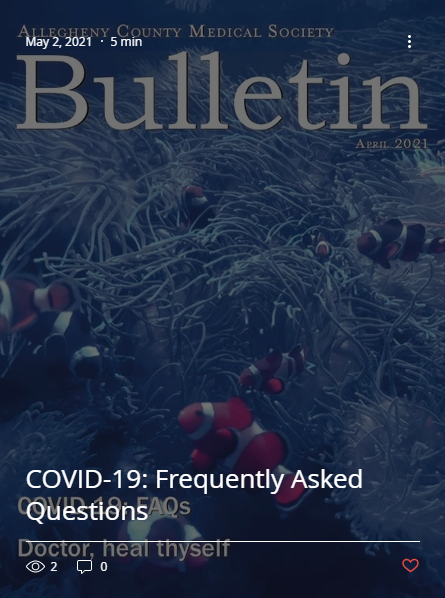
Clinical and public health guidance related to COVID-19 has evolved over the last year. The Allegheny County Health Department provides the following frequently asked questions (FAQs) for physicians on common clinical and public health COVID-19 scenarios.
What is the difference between isolation and quarantine?
Isolation separates people with an infection (e.g., COVID-19) from people who have not been diagnosed with the infection, while quarantine separates and restricts the movement of people who were exposed to COVID-19 but are not yet experiencing signs or symptoms of the infection.
What is a close contact?
For COVID-19, a close contact is anyone who was within 6 feet of an infected person for a total of 15 minutes or more. An infected person can spread COVID-19 starting from 48 hours (or two days) before the person has any symptoms or tests positive for COVID-19. A person is still considered a close contact even if they were wearing a mask while they were around someone with COVID-19.
What are the current guidelines for isolation?
Isolation for people who were diagnosed with COVID-19 is 10 days from the onset of their symptoms or 24 hours after symptoms improve, whichever is longer. People who are asymptomatic should remain isolated for 10 days from the date of their positive test.
What are the current guidelines for quarantine?
A 14-day quarantine after the last possible exposure for close contacts of a case is the best way to limit the spread of COVID-19. Quarantine may be ended early if the following conditions are met:
1) After 10 days if a person does not develop any symptoms with careful monitoring.
2) If local testing resources are available, quarantine can end after seven days if the person does not develop symptoms with careful daily monitoring AND tests negative for the virus. The test should be performed on the fifth day after the exposure or later. Quarantine cannot end before day seven. The Health Department prefers that a PCR test (rather than an antigen test) be used to determine if a person can leave quarantine after seven days. Individuals should continue to monitor for symptoms for the full 14 days even if they meet the criteria to leave quarantine early.
How do quarantine guidelines apply to household members?
If household members are in quarantine together and one or more members develops COVID-19, their last possible exposure will be the final day of the COVID-19 patient’s isolation (e.g., if a patient’s final day of isolation is on the first day of the month, the first day of their household members’ extended quarantine would begin on the second day of the month).
Is there a summary of isolation and quarantine guidelines suitable for patients?
Current isolation and quarantine guidelines, suitable for distribution to patients, are available here: https://www.alleghenycounty.us/uploadedFiles/Allegheny_Home/Health_Department/Resources/COVID-19/Docs/Isolation%20Quarantine%20Basics(1).pdf
How are the isolation and quarantine guidelines affected if individuals are vaccinated?
Individuals are considered “fully vaccinated” two weeks after their final dose of COVID-19 vaccine.
Although the risk that fully vaccinated people could become infected with COVID-19 is low, any fully vaccinated person who experiences symptoms consistent with COVID-19 should isolate themselves from others, be clinically evaluated for COVID-19 and tested for SARS-CoV-2 if indicated. Fully vaccinated individuals who have a positive test result for COVID-19 should follow standard isolation guidance. [https://www.cdc.gov/coronavirus/2019-ncov/vaccines/fully-vaccinated-guidance.html#anchor_1617376555813]
In non-healthcare environments, following an exposure to someone with suspected or confirmed COVID-19, fully vaccinated people without symptoms do not need to quarantine or be tested but should still monitor for symptoms for 14 days following an exposure. If they experience symptoms, they should be clinically evaluated for COVID-19, including SARS-CoV-2 testing, if indicated. [https://www.cdc.gov/coronavirus/2019-ncov/vaccines/fully-vaccinated-guidance.html#anchor_1617376555813]
Fully vaccinated healthcare professionals with higher-risk exposures who are asymptomatic do not need to be restricted from work for 14 days following their exposure. Work restrictions for the following fully vaccinated HCP populations with higher-risk exposures should still be considered for healthcare professionals with underlying immunocompromising conditions. [https://www.cdc.gov/coronavirus/2019-ncov/hcp/infection-control-after-vaccination.html]
If a household has known COVID cases, what is the benefit of having each member tested?
The CDC, PADOH and ACHD recommend testing for all persons exposed to a case, including household members, unless they are fully vaccinated or have tested positive for COVID within the past three months. A positive test result can affect quarantine decisions within a household and may impact the need for future quarantine or testing for the individual should another close contact occur. Close contacts and household contacts should be tested (five to seven days after exposure) whether they are asymptomatic or symptomatic. Patients in need of testing can find convenient testing sites at: https://www.alleghenycounty.us/Health-Department/Resources/COVID-19/Information-on-COVID-19-Testing.aspx.
Children tend to have mild symptoms or none at all. Why should children be tested?
CDC recommends all people with symptoms of COVID-19, including children, get tested. A positive test result can affect quarantine decisions within a household and may impact the need for future quarantine or testing for the patient should another close contact occur.
How long should a patient who has recovered from COVID wait before receiving a COVID vaccination?
COVID-19 patients can receive vaccination after their isolation period has ended.
How long should a patient who has received monoclonal antibody treatment for COVID wait before receiving a COVID vaccination?
Patients treated for COVID-19 with monoclonal antibodies or convalescent plasma should wait 90 days before getting a COVID-19 vaccine.
What should occur if a patient doesn’t receive their second dose of vaccine within 42 days?
Information is limited on the effectiveness of receiving the second dose later than six weeks after the first shot; however, patients do not need to restart their vaccine series if they receive their second dose after 42 days. This guidance may be updated as more information becomes available. [https://www.cdc.gov/coronavirus/2019-ncov/vaccines/second-shot.html]
Should pregnant women be vaccinated?
The American College of Obstetricians and Gynecologists (ACOG) recommends that COVID-19 vaccines should not be withheld from pregnant individuals who choose to be vaccinated. ACOG notes, “While limited, current safety data on the use of COVID-19 vaccines in pregnancy do not indicate any safety concerns.” [https://www.acog.org/-/media/project/acog/acogorg/files/pdfs/clinical-guidance/practice-advisory/covid19vaccine-conversationguide-121520-v2.pdf?la=en&hash=439FFEC1991B7DD3925352A5308C7C42]
Should breastfeeding individuals be vaccinated?
Yes, breastfeeding individuals should be vaccinated similar to non-lactating individuals.
Where can I find local information about COVID-19?
• Allegheny County COVID-19 case data: https://www.alleghenycounty.us/Health-Department/resources/COVID-19/Covid-19.aspx
• Allegheny County COVID-19 vaccination information: https://www.alleghenycounty.us/Health-Department/Resources/COVID-19/COVID-19-Vaccine-Information.aspx; Allegheny County Health Department COVID-19 vaccination registration: https://vax4.alleghenycounty.us/patient/s/
• Foreign language translations of Allegheny County COVID-19 information: https://www.alleghenycounty.us/Health-Department/Resources/COVID-19/Information-for-Specific-Groups/Foreign-Language-Information-on-COVID-19.aspx
To stay informed about public health issues that are relevant to physicians, please consider registering for the following information services:
• CDC’s COCA (Clinician Outreach and Communication Activity): https://emergency.cdc.gov/coca/index.asp [“COCA prepares clinicians to respond to emerging health threats and public health emergencies by communicating relevant, timely information related to disease outbreaks, disasters, terrorism events, and other health alerts.”] “Join the COCA mailing list” is a menu option on the lower left.
• HAN (Health Alert Network): https://emergency.cdc.gov/han/index.asp [“CDC’s primary method of sharing cleared information about urgent public health incidents with public information officers; federal, state, territorial, tribal, and local public health practitioners; clinicians; and public health laboratories.”] Registration is available via the “Sign up for HAN updates” option on the left.
• Pennsylvania Health Alert Network (PA-HAN): https://www.health.pa.gov/topics/prep/PA-HAN/Pages/HAN.aspx [The PA Health Alert Network (PA HAN), established under a cooperative agreement with CDC, serves as a communication network among state and local public health agencies, health care providers, hospitals and emergency management officials.] The “sign up” option is in the fourth paragraph of the webpage.

